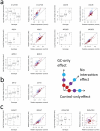Interactions between glucocorticoid treatment and cis-regulatory polymorphisms contribute to cellular response phenotypes
- PMID: 21750684
- PMCID: PMC3131293
- DOI: 10.1371/journal.pgen.1002162
Interactions between glucocorticoid treatment and cis-regulatory polymorphisms contribute to cellular response phenotypes
Abstract
Glucocorticoids (GCs) mediate physiological responses to environmental stress and are commonly used as pharmaceuticals. GCs act primarily through the GC receptor (GR, a transcription factor). Despite their clear biomedical importance, little is known about the genetic architecture of variation in GC response. Here we provide an initial assessment of variability in the cellular response to GC treatment by profiling gene expression and protein secretion in 114 EBV-transformed B lymphocytes of African and European ancestry. We found that genetic variation affects the response of nearby genes and exhibits distinctive patterns of genotype-treatment interactions, with genotypic effects evident in either only GC-treated or only control-treated conditions. Using a novel statistical framework, we identified interactions that influence the expression of 26 genes known to play central roles in GC-related pathways (e.g. NQO1, AIRE, and SGK1) and that influence the secretion of IL6.
Conflict of interest statement
The authors have declared that no competing interests exist.
Figures




References
Publication types
MeSH terms
Substances
Grants and funding
LinkOut - more resources
Full Text Sources
Medical
Molecular Biology Databases
Miscellaneous

